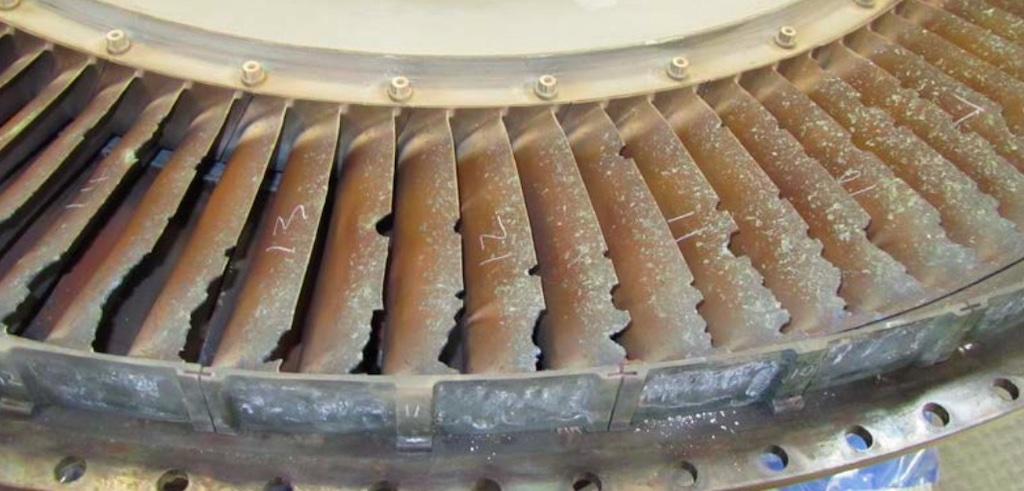
The flight crew of a Boeing 747-400 noticed a pronounced EGT exceedance after leveling off at FL380 followed by vibrations that were outside of specified limits. Post-incident investigation revealed failure and separation of a single intermediate-pressure turbine blade.
Fortunately, engine manufacturers have worked incessantly to improve the efficiency and reliability of their powerplants when operating in various airborne environments.
For example, the airborne environment often contains rain. Ingestion of extreme quantities of rain or hail through the engine core may ultimately produce engine surging, power loss and engine flameout. Engines are now designed and certified to endure ingestion of large hailstones under the conditions of maximum true airspeed with the engine at maximum continuous power without causing unacceptable mechanical damage or unacceptable power or thrust loss after the ingestion or require the engine to be shut down.
It is vital to be aware of the turbine’s vulnerability in these environments and take the proper proactive steps when prescribed as well as the additional maintenance. Shorter maintenance intervals are more costly, but the long-term cost savings more than offset that expense.
Pay Attention To Engine Care Sections
There are many sections in aircraft manuals that seem buried but contain important information. One of these examples is the care of your engine during ground operations in wintry weather.
Blowing snow, freezing precipitation, freezing fog, slush, ground contaminants or even airport snow removal operations can cause contamination on a wide spectrum of components within a jet engine. Even after an engine is started it is possible for snow and slush to accumulate within the engine intake ducting as well as the rear surfaces of engine compressor/fan blades during ground operations in conditions of moderate to heavy freezing precipitation.
Ice accumulation on the surfaces of engine compressor/fan blades may severely affect the aerodynamic performance of the blades and cause compressor stall, engine surging and engine malfunctioning and/or reduced thrust.
Jet engines are susceptible to accumulation of ice on fan blades in freezing fog or freezing precipitation conditions when the engine is at or near its ground idle speed. Isn’t engine anti-ice capable of preventing this ice accumulation? No, engine anti-ice systems are designed primarily to deter the accumulation of ice on the intake of the engine nacelle. Ice that has accumulated on the fan blades while the engine is at idle speed must be removed by engine run-ups prior to takeoff.
Ground ice shed procedures usually contain an acceleration of the engine RPM to a minimum thrust setting and then a dwell time at that thrust setting. The acceleration increases centrifugal forces and slightly flexes the fan blades resulting in mechanical shedding of ice. Asymmetric fan ice shedding may cause momentary increases in perceived and indicated engine vibration. Fan vibration levels should return to normal levels as fan ice sheds. Also, don’t forget that ice contamination of engine probes can cause erroneous flight deck instrument indications.
Exceedances Require Inspection
The Australian Civil Aviation Safety Authority’s airworthiness bulletin, “Engines Operating in a Fire Fighting Environment,” advises operators of aerial firefighting aircraft that all exceedances and engine surge events must be inspected and corrected in accordance with the approved data from the manufacturer. Manufacturers will often specify a thorough visual as well as boroscopic inspection (BSI) of the engine inlet, compressor and turbine airfoil surfaces for signs of physical damage.
An inspection of the engine’s inner gas path for nicking, dents or bending of blades, debonding and re-deposition of plasma coating on the surfaces of blades and/or guide vanes should also be performed. In addition, turbine blade surfaces should be inspected for signs of loss of coating, oxidation, exfoliation and creep. If contaminant ingestion is confirmed by any of these findings, then removal of accessories for bench-check and engine compressor wash is recommended.
The bottom line is that pilots need to take care of their engines. Observing operating limits, avoiding adverse airborne environments, utilizing the manufacturer’s guidelines for normal and all-weather operations, and engine trend monitoring are important elements to minimizing maintenance costs and maximizing engine reliability.
Engine Limitations Are Not Mere Suggestions, Part 1: https://aviationweek.com/business-aviation/aircraft-propulsion/engine-l…
Engine Limitations Are Not Mere Suggestions, Part 2:
https://aviationweek.com/business-aviation/aircraft-propulsion/engine-l…





